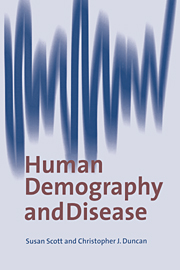Book contents
- Frontmatter
- Contents
- Preface
- Conversion table for imperial to metric units
- 1 Introduction
- 2 Tools for demography and epidemiology
- 3 Identification of population oscillations: a case study
- 4 Density-dependent control and feedback
- 5 Modelling the endogenous oscillations and predictions from timeseries analysis
- 6 Cycles in the grain price series
- 7 Interactions of exogenous cycles: a case study
- 8 Mortality crises and the effects of the price of wool
- 9 Modelling epidemics for the demographer: the dynamics of smallpox in London
- 10 Non-linear modelling of the 2-yearly epidemics of smallpox: the genesis of chaos?
- 11 Measles and whooping cough in London
- 12 Integration of the dynamics of infectious diseases with the demography of London
- 13 Smallpox in rural towns in England in the 17th and 18th centuries
- 14 Infectious diseases in England and Wales in the 19th century
- 15 Prospectives – towards a metapopulation study
- References
- Index
2 - Tools for demography and epidemiology
Published online by Cambridge University Press: 25 January 2010
- Frontmatter
- Contents
- Preface
- Conversion table for imperial to metric units
- 1 Introduction
- 2 Tools for demography and epidemiology
- 3 Identification of population oscillations: a case study
- 4 Density-dependent control and feedback
- 5 Modelling the endogenous oscillations and predictions from timeseries analysis
- 6 Cycles in the grain price series
- 7 Interactions of exogenous cycles: a case study
- 8 Mortality crises and the effects of the price of wool
- 9 Modelling epidemics for the demographer: the dynamics of smallpox in London
- 10 Non-linear modelling of the 2-yearly epidemics of smallpox: the genesis of chaos?
- 11 Measles and whooping cough in London
- 12 Integration of the dynamics of infectious diseases with the demography of London
- 13 Smallpox in rural towns in England in the 17th and 18th centuries
- 14 Infectious diseases in England and Wales in the 19th century
- 15 Prospectives – towards a metapopulation study
- References
- Index
Summary
Parish registers – a valuable data base for theoretical population study
The parish register series of England, many of which began in the 16th century, represent a data series of immense value to workers in historical demography and have been fully exploited by Wrigley & Schofield (1981) in their seminal work The Population History of England 1541–1871. They showed that by using such relatively simple techniques as aggregative analysis and family reconstitution it is possible to extract and synthesise a wealth of data. A study of the demography must begin with aggregative analysis and, as we describe in the following chapters, this can form the basis for a detailed investigation by time-series analysis. Wrigley (1966) provided a comprehensive description of the techniques of aggregative analysis, covering such topics as choice of parish and the extraction and tabulation of data. The information derived has previously been limited to annual or monthly totals of baptisms, burials and marriages, and it is used primarily to examine short-term fluctuations and their interrelationships, to give an impression of overall long-run trends and to highlight major demographic events such as mortality crises. It is a useful method to examine large-scale changes in demographic behaviour, but it is not possible to study the economic and demographic forces at the level of the individual family nor, for example, the series of infant deaths, and its effectiveness is hindered by underregistration of events and by breaks in record-keeping. Wrigley & Schofield (1981) and Razzell (1994,1995) have taken great care in assessing the accuracy of their data.
- Type
- Chapter
- Information
- Human Demography and Disease , pp. 16 - 33Publisher: Cambridge University PressPrint publication year: 1998



